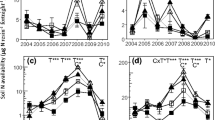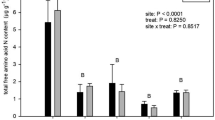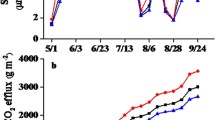Abstract
Soil amino acids are often an important source of nitrogen (N) for plants, and anticipated global changes, including climate warming and rising atmospheric CO2 levels, have the potential to alter plant and microbial production and consumption of this N source in soils. We determined soil amino acid composition over a 1-year period at diurnal and seasonal time scales in a multi-factor global change experiment with elevated CO2 and warming in native semiarid grassland. Soil amino acids were collected in April, May and June of 2011 and April 2012 using a soil water perfusion and extraction method that minimized soil disturbance. This was a particular advantage when taking diurnal measurements. The extracts were analyzed by ultra performance liquid chromatography. We detected 16 different soil amino acids throughout the study, and glutamine/glutamate (glu-x), arginine, serine and asparagine/aspartate (asp-x) were consistently at highest relative concentrations, comprising 3–41, 6–20, 2–22 and 7–24 % of total amino acids, respectively. No direct effects of experimental warming or elevated CO2 on soil amino acid composition were observed. However, the relative abundance of individual soil amino acids shifted diurnally and seasonally with changes in soil temperature and soil moisture. Glu-x and arginine increased and serine decreased with higher temperature, while asp-x and serine increased and arginine decreased with higher moisture. Overall, the relative abundances of soil amino acids responded more strongly to both diurnal and seasonal changes in temperature and soil moisture than to elevated atmospheric CO2 and experimental warming.





Similar content being viewed by others
References
Amelung W, Zhang X, Flach KW (2006) Amino acids in grassland soils: climatic effects on concentrations and chirality. Geoderma 130:207–217
Andresen LC, Michelsen A, Jonasson S, Beier C, Ambus P (2009) Glycine uptake in heath plants and soil microbes responds to elevated temperature, CO2 and drought. Acta Oecol 35:786–796
Blumenthal D (2009) Carbon addition interacts with water availability to reduce invasive forb establishment in a semi-arid grassland. Biol Invasions 11:1281–1290
Brzostek ER, Blair JM, Dukes JS et al (2010) The effect of experimental warming and precipitation change on proteolytic enzyme activity: positive feedbacks to nitrogen availability are not universal. Glob Change Biol 18:2617–2625
Cardon ZG, Gage DJ (2006) Resource exchange in the rhizosphere: molecular tools at the microbial perspective. Annu Rev Ecol Evol Syst 37:459–488
Carrillo Y, Pendall E, Dijkstra FA, Morgan JA, Newcomb JM (2011) Response of soil organic matter pools to elevated CO2 and warming in a semi-arid grassland. Plant Soil 347:339–350
Carrillo Y, Dijkstra FA, Pendall E, Morgan JA, Blumenthal DM (2012) Controls over soil nitrogen pools in a semiarid grassland under elevated CO2 and warming. Ecosystems 15:761–774
Chapin FS III, Shaver GR, Kedrowski RA (1986) Environmental controls over carbon, nitrogen and phosphorus fractions in Eriophorum voginowm in Alaskan tussock tundra. J Ecol 74:167–195
Chapin FS III, Moilanen L, Kielland K (1993) Preferential use of organic nitrogen for growth by a non-mycorrhizal sedge. Nature 361:150–153
Chen J, Williams DG (2013) A novel in situ water perfusion and extraction method for soil amino acid quantification. Soil Biol Biochem 59:86–88
Christensen S (1983) Nitrous oxide emission from a soil under permanent grass: seasonal and diurnal fluctuations as influenced by manuring and fertilization. Soil Biol Biochem 15:531–536
Clarke KR, Gorley RN (2006) PRIMER v6: user manual/tutorial. PRIMER-E, Plymouth
Conant RT, Ryan MG, Agren GI et al (2011) Temperature and soil organic matter decomposition rates—synthesis of current knowledge and a way forward. Glob Change Biol 17:3392–3404
Dai A, Trenberth KE, Qian T (2004) A global dataset of Palmer Drought Severity Index for 1870–2002: relationship with soil moisture and effects of surface warming. J Hydrometeorol 5:1117–1130
DeLuca TH, Keeney DR, McCarty GW (1992) Effect of freeze–thaw events on mineralization of soil nitrogen. Biol Fertil Soils 14:116–120
Diez VA, Alvarez A (2001) Compositional and nutritional studies on two wild edible mushrooms from northwest Spain. Food Chem 75:417–422
Dijkstra FA, Blumenthal D, Morgan JA, Pendall E, Carrillo Y, Follett RF (2010) Contrasting effects of elevated CO2 and warming on nitrogen cycling in a semiarid grassland. N Phytol 187:426–437
Falkengren-Grerup U, Mansson KF, Olsson MO (2000) Uptake capacity of amino acids by ten grasses and forbs in relation to soil acidity and nitrogen availability. Environ Exp Bot 44:207–219
Harrison KA, Bol R, Bardgett RD (2007) Preferences for different nitrogen forms by coexisting plant species and soil microbes. Ecology 4:989–999
Harrison KA, Bol R, Bardgett RD (2008) Do plant species with different growth strategies vary in their ability to compete with soil microbes for chemical forms of nitrogen? Soil Biol Biochem 40:228–237
Hofmockel KS, Schlesinger WH, Jackson RB (2007) Effects of elevated atmospheric carbon dioxide on amino acid and NH4 +–N cycling in a temperate pine ecosystem. Glob Change Biol 13:1950–1959
Hungate BA, Dijkstra P, Johnson DW, Hinkle R, Drake BG (1999) Elevated CO2 increases nitrogen fixation and decreases soil nitrogen mineralization in Florida scrub oak. Glob Change Biol 5:781–789
Hungate BA, Jaeger CH III, Gamara G, Chapin FS III, Field CB (2000) Soil microbiota in two annual grasslands: responses to elevated atmospheric CO2. Oecologia 124:589–598
Inselsbacher E, Näsholm T (2012) The below-ground perspective of forest plants: soil provides mainly organic nitrogen for plants and mycorrhizal fungi. N Phytol 195:329–334
Inselsbacher E, Oyewole OA, Näsholm T (2014) Early season dynamics of soil nitrogen fluxes in fertilized and unfertilized boreal forests. Soil Biol Biochem 74:167–176
IPCC, Working Group I Fifth Assessment Report (2013) Climate change 2013: working group I: the physical science basis. Cambridge University Press, Cambridge
Jin VL, Evans RD (2010) Elevated CO2 increases plant uptake of organic and inorganic N in the desert shrub Larrea tridentata. Oecologia 163:257–266
Jones DL (1999) Amino acid biodegradation and its potential effects on organic nitrogen capture by plants. Soil Biol Biochem 31:613–622
Jones DL, Kielland K (2002) Soil amino acid turnover dominates the nitrogen flux in permafrost-dominated taiga forest soils. Soil Biol Biochem 34:209–219
Kielland K (1994) Amino acid absorption by arctic plants: implications for plant nutrition and nitrogen cycling. Ecology 75:2373–2383
Kimball BA, Conley MM, Wang S, Lin X, Luo C, Morgan J, Smith D (2008) Infrared heater arrays for warming ecosystem field plots. Glob Change Biol 14:309–320
Lauenroth WK, Milchunas DG (1992) Natural grasslands; introduction and western hemisphere. In: Coupland RT (ed) Ecosystems of the world, vol 8A. Elsevier, New York, pp 183–226
Lesuffleur F, Paynel F, Bataillé MP, Le Deunff E, Eliquet JB (2007) Root amino acid exudation: measurement of high efflux rates of glycine and serine from six different plant species. Plant Soil 294:235–246
Lipson DA, Monson RK (1998) Plant–microbe competition for soil amino acids in the alpine tundra: effects of freeze–thaw and dry–rewet events. Oecologia 113:406–414
Lipson DA, Raab TK, Schmidt SK, Monson RK (2001) An empirical model of amino acid transformations in an alpine soil. Soil Biol Biochem 33:189–198
Luo Y, Su B, Currie WS et al (2004) Progressive nitrogen limitation of ecosystem responses to rising atmospheric carbon dioxide. Bioscience 54:731–739
Melillo JM, Steudler PA, Aber JD, Newkirk K, Lux H, Bowles FP, Catricala C, Magill A, Ahrens T, Morrisseau S (2002) Soil warming and carbon-cycle feedbacks to the climate system. Science 298:2173–2176
Miglietta F, Hoosbeek MR, Foot J, Gigon F, Hassinen A, Heijmans M, Peressotti A, Saarienen T, van Breemen N, Wallen B (2001) Spatial and temporal performance of the miniface (free air CO2 enrichment) system on bog ecosystems in northern and central Europe. Environ Monit Assess 66:107–127
Mitchell JFB, Manabe S, Meleshko V, Tokioka T (1990) Equilibrium climate change and its implications for the future. In: Houghton JT et al (eds) Climate change. The IPCC scientific assessment. Cambridge University Press, New York, pp 131–174
Morgan JA, Pataki DE, Korner C, Clark H, Del Grosso SJ, Grunzweig JM, Knapp AK, Mosier AR, Newton PCD, Niklaus PA, Nippert JB, Nowak RS, Parton WJ, Polley HW, Shaw MR (2004) Water relations in grassland and desert ecosystems exposed to elevated atmospheric CO2. Oecologia 140:11–25
Näsholm T, Edfast AB, Ericsson A, Norden LG (1994) Accumulation of amino acids in some boreal forest plants in response to increased nitrogen availability. N Phytol 126:137–143
Näsholm T, Kielland K, Ganeteg U (2009) Uptake of organic nitrogen by plants. N Phytol 182:31–48
Ohlson M, Nordin A, Näsholm T (1995) Accumulation of amino acids in forest plants in relation to ecological amplitude and nitrogen supply. Funct Ecol 9:596–605
Phillips DA, Fox TC, King MD, Bhuvaneswari TV, Teuber LR (2004) Microbial products trigger amino acid exudation from plant roots. Plant Physiol 136:2887–2894
Raab TK, Lipson DA, Monson RK (1996) Non-mycorrhizal uptake of amino acids by roots of the alpine sedge Kobresia myosuroides: implications for the alpine nitrogen cycle. Oecologia 108:488–494
Raab TK, Lipson DA, Monson RK (1999) Soil amino acid utilization among species of the Cyperaceae: plant and soil processes. Ecology 80:2408–2419
Rayment MB, Jarvis PG (2006) Temporal and spatial variation of soil CO2 efflux in a Canadian boreal forest. Soil Biol Biochem 32:35–45
Reich PB, Hobbie SE, Lee T, Ellsworth DS, West JB, Tilman D, Knops JMH, Naeem S, Trost J (2006) Nitrogen limitation constrains sustainability of ecosystem response to CO2. Nature 440:922–925
Rozycki H, Strzelczyk E (1986) Free amino acids production by actinomycetes, isolated from soil, rhizosphere, and mycorrhizosphere of pine (Pinns sylvestris L.). Zent Mikrobiol 141:423–429
Rustad LE, Campbell JL, Marion GM, Norby RJ, Mitchell MJ, Hartley AE, Cornelissen JHC, Gurevitch J, News GCTE (2001) A meta-analysis of the response of soil respiration, net nitrogen mineralization, and aboveground plant growth to experimental ecosystem warming. Oecologia 126:543–562
Sala OE, Lauenroth WK, Parton WJ (1992) Long-term soil water dynamics in the shortgrass steppe. Ecology 73:1175–1181
Saugier B, Roy J, Mooney HA (2001) Estimations of global terrestrial productivity: converging toward a single number? In: Roy J, Saugier B, Mooney HA (eds) Terrestrial global productivity. Academic Press, San Diego
Sauheitl L, Glaser B, Dippold M, Leiber K, Weigelt A (2010) Amino acid fingerprint of a grassland soil reflects changes in plant species richness. Plant Soil 334:353–363
Schimel JP, Bennett J (2004) Nitrogen mineralization: challenges of a changing paradigm. Ecology 85:591–602
Schimel JP, Chapin FS III (1996) Tundra plant uptake of amino acid and NH4 + nitrogen in situ: plants compete well for amino acid N. Ecology 77:2142–2147
Sowden FJ, Chen Y, Schinitzer M (1977) The nitrogen distribution in soils formed under widely different climatic conditions. Geochim Cosmochim Acta 41:1524–1526
Top SM, Filley TR (2014) Effects of elevated CO2 on the extractable amino acids of leaf litter and fine roots. N Phytol. doi:10.1111/nph.12762
Wagner GH, Mutatkar VK (1968) Amino acid components of soil organic matter formed during humification of 14C glucose. Soil Sci Soc Am J 32:683–686
Weigelt A, Bol R, Bardgett RD (2005) Preferential uptake of soil nitrogen forms by grassland plant species. Oecologia 142:627–635
Werdin-Pfisterer NR, Kielland K, Boone RD (2009) Soil amino acid composition across a boreal forest successional sequence. Soil Biol Biochem 41:1210–1220
West NE (1991) Nutrient cycling in soils of semi arid and arid regions. In: Skujins J (ed) Semi arid lands and deserts: soil resource and reclamation. Marcel Dekker, Inc., New York, pp 295–332
Williams LE, Miller AJ (2001) Transporters responsible for the uptake and partitioning of nitrogenous solutes. Annu Rev Plant Physiol Plant Mol Biol 52:659–688
Yuste JC, Baldocchi DD, Gershenson A, Goldstein A, Misson L, Wong S (2007) Microbial soil respiration and its dependency on carbon inputs, soil temperature and moisture. Glob Change Biol 13:2018–2035
Zak DR, Pregitzer KS, King JS, Holmes WE (2000) Elevated atmospheric CO2, fine roots and the response of soil microorganisms: a review and hypothesis. N Phytol 147:201–222
Acknowledgments
Special thanks to Dan Lecain, David Smith and Erik Hardy with the USDA-ARS Rangeland Resources Research Unit for providing air and soil moisture and temperature data and for building and maintaining the PHACE project, Chandelle MacDonald and Erik A. Hobbie for internal manuscript review, David E. Legg for SAS consultation and David J. Perry and Justin Jones for UPLC consultation. This material is based upon work supported by the US Department of Agriculture Agricultural Research Service Climate Change, Soils and Emissions Program, USDA-CSREES Soil Processes Program (#2008-35107-18655), US Department of Energy Office of Science (BER), through the Terrestrial Ecosystem Science Program (#DE-SC0006973) and the Western Regional Center of the National Institute for Climatic Change Research, and by the National Science Foundation (DEB#1021559). Any opinions, findings, and conclusions or recommendations expressed in this material are those of the author(s) and do not necessarily reflect the views of the National Science Foundation.
Author information
Authors and Affiliations
Corresponding author
Additional information
Responsible Editor: Stuart Grandy.
Electronic supplementary material
Below is the link to the electronic supplementary material.
Rights and permissions
About this article
Cite this article
Chen, J., Zelikova, T.J., Pendall, E. et al. Daily and seasonal changes in soil amino acid composition in a semiarid grassland exposed to elevated CO2 and warming. Biogeochemistry 123, 135–146 (2015). https://doi.org/10.1007/s10533-014-0057-0
Received:
Accepted:
Published:
Issue Date:
DOI: https://doi.org/10.1007/s10533-014-0057-0




